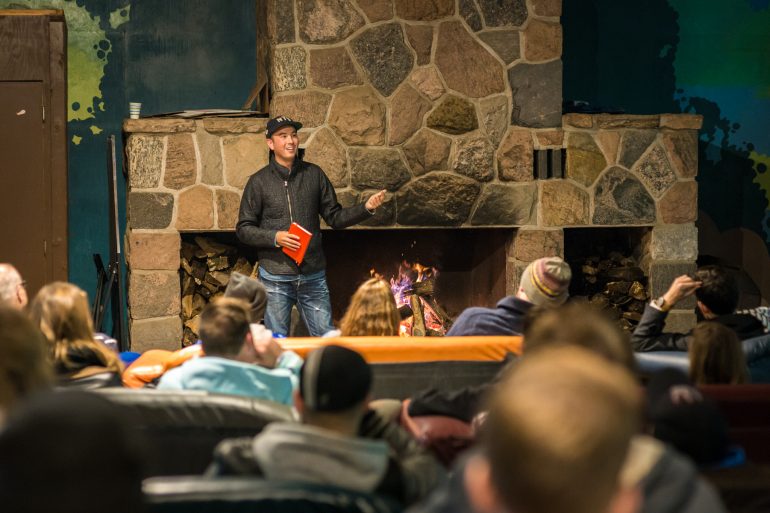In case you missed it, #Firesideconf brought together 80 people from the tech community for speeches from fellow entrepreneurs, s’mores, and hanging out in a summer camp setting.
After lunch at #Firesideconf, Steve Tam, the Canadian marketing manager for tech and design at Indiegogo, gave his keynote address where he talked about the myth of work-life balance. “I hate talking about work-life balance because it implies that there are two finite sides of this scale, like you have to take away from work to get life or you have to take away something from life to do better at work,” Tam explained.
Instead, Tam’s approach to the mythical work-life balance is, simply, to find a middle ground. He said that, once we start removing those on/off switches where we’re only working or not working in certain spaces, it becomes much less stressful to work in certain spaces where you associate only with work, or vice versa. “Sometimes I can be on my phone in work mode, but I can also be in personal mode,” Tam said. “As I’ve started to remove barriers between what means work and what isn’t work, each of these spaces in your life start to become more enjoyable, so you don’t look at your office and think ‘I hate this space’.”
“We’re complacent in our current situations, and we don’t push the boundaries of the jobs that we’re in because we always think we’ll find it in the next job.”
– Steve Tam, Indiegogo
Tam said that people should commit to a one-year ‘mastering yourself’ program, where you ask yourself how you want to improve your work or life, and try to integrate those goals into your day-to-day life. Tam did this with trying to improve his public speaking skills. He started talking at a few events a few years ago, in what he called “super awkward, bad TA-style, reading-off-the-slide presentations,” and made it part of his work to give presentations on the Indiegogo brand, which meant that he could both improve his speaking skills and work at the same time.
“For a lot of companies, culture means having a ping pong table and going to the bar every Friday, but I think it runs much deeper than that,” Tam said. “Whether you’re a two-person team or a 200-person team, you need every person to be the best version of themselves. I think that companies that empower their employees are the ones that are growing the fastest.”
Tam explained that companies that giving employees room to grow is the start to building company culture. “Everyone wants a vacation until you spend a month on the beach and think that it’s boring, and everyone wants to work remotely until they realize it isn’t the best,” Tam said. “Healthy workspaces give employees space to learn what’s important to them and not assume everyone knows what they want. You need the freedom to do what’s important to you so you can feel fulfilled and inspired and bring that energy back to your workspace.”
To keep himself accountable, Tam provided a list of four key tips for his “mastering yourself” program to help people become better versions of themselves in their day-to-day life.
Surround yourself with people who live the life you want to live.
“I went through a massive friend turonver in the last four to five years, and a lot of people are unhappy with me,” Tam said. “It also means that the new group that I’m spending my time with are doing things that I admire and I’m passionate about, and it helps me to push my boundaries.”
Create physical spaces that you want to be in.
Tam said that everyone has that one space in their house that they’re proud of, whether it’s a bedroom, home office, or a kitchen. “I challenge you to take that passion you put into that space and do that to other spaces that you spend a large part of your day in,” Tam said.
Create three spaces of time.
“We’re really good at two spaces already. We’re good at working and not working. Try to get better at that space in between working and not working,” Tam said. As an example, he said that whenever he takes a vacation in another city, he tries to meet new people and do soft work. “I’ll find myself in an amazing conversation and coming back to that scene a few months later, and you start to expand the space where work is because we let it fall into the time where we’re not working.”
Focus on improvement in the present.
Tam said that people’s constant focus on getting the next great opportunity, the next great job, means that any focus on self-improvement is put into the future. “Push your current job and current position as far as possible until whoever you report to says ‘I don’t know if this is the right fit anymore’,” Tam said. “We’re very complacent in our current situations and we don’t push the boundaries of the jobs that we’re in because we always think we’ll find it in the next job.”
Photos courtesy Billy Lee @makingsenses.


